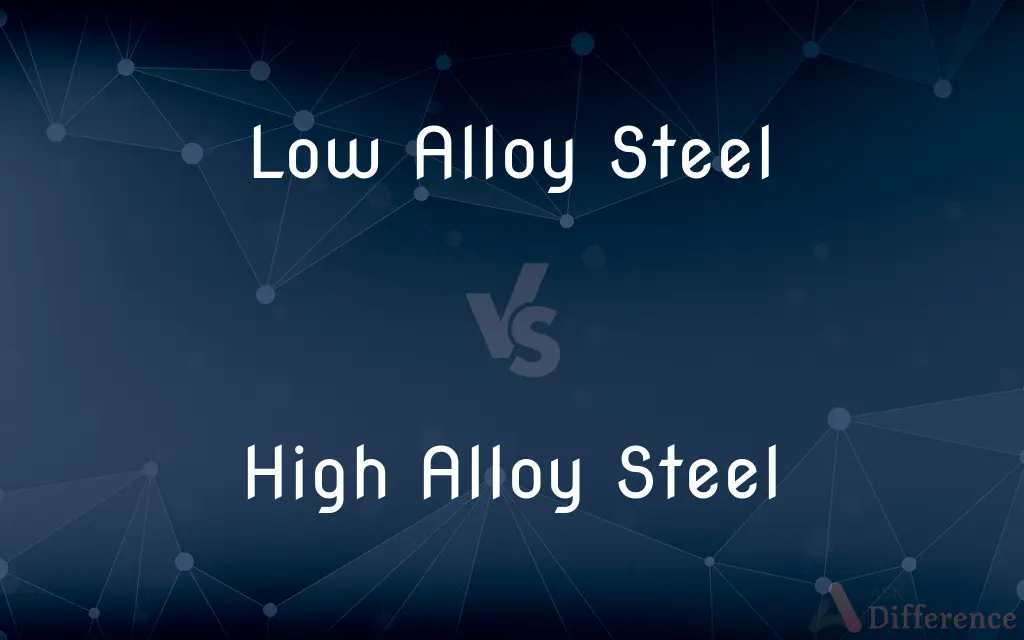Low Alloy Steel vs. High Alloy Steel — What's the Difference?
By Tayyaba Rehman — Published on January 14, 2024
Low alloy steel contains a smaller percentage (typically less than 5%) of alloying elements, offering moderate improvements in strength and mechanical properties. High alloy steel contains a higher percentage (more than 5%) of alloying elements.

Difference Between Low Alloy Steel and High Alloy Steel
Table of Contents
ADVERTISEMENT
Key Differences
Low alloy steel is steel with alloying elements totaling less than 5%. These elements, like chromium, molybdenum, and nickel, enhance the steel's mechanical properties without significantly altering its composition. High alloy steel, in contrast, has more than 5% alloying elements, which significantly change its properties, making it suitable for specialized applications.
Low alloy steels are known for their improved strength and toughness compared to carbon steel, but they don’t have the extreme properties of high alloy steels. High alloy steels, such as stainless steel, exhibit superior corrosion resistance, heat resistance, and hardness.
Applications of low alloy steel are broad and include structural components, pipelines, and machinery, where enhanced strength is needed. High alloy steel is used in more demanding environments, like chemical plants, power generation, and medical equipment, due to its specialized properties.
Low alloy steel is generally more weldable and malleable than high alloy steel. The latter requires specific processing techniques due to its high alloy content, which can lead to challenges in welding and shaping.
Cost-wise, low alloy steels are more affordable and widely available than high alloy steels. The extensive processing and high concentration of expensive elements make high alloy steels more costly.
ADVERTISEMENT
Comparison Chart
Alloying Elements
Less than 5% alloy content.
More than 5% alloy content.
Mechanical Properties
Improved strength and toughness.
Superior corrosion resistance, heat resistance, and hardness.
Common Applications
Structural components, pipelines, machinery.
Chemical plants, power generation, medical equipment.
Weldability and Malleability
Generally more weldable and malleable.
Requires specialized techniques for welding and shaping.
Cost
More affordable, widely available.
More expensive due to high alloy content and processing.
Compare with Definitions
Low Alloy Steel
Commonly used in general engineering and structural applications.
Low alloy steel was used in the machinery for its improved weldability.
High Alloy Steel
More costly and requires specialized processing.
The aerospace components were made of high alloy steel for enhanced performance.
Low Alloy Steel
Contains less than 5% alloying elements like chromium and nickel.
The bridge was constructed with low alloy steel for enhanced durability.
High Alloy Steel
Used in demanding industrial and technological applications.
For the high-temperature furnace, high alloy steel was necessary.
Low Alloy Steel
Offers a balance between improved properties and cost.
For the budget-conscious project, low alloy steel was the ideal choice.
High Alloy Steel
High alloy steel contains a high percentage of alloying elements.
High alloy steel is used in medical equipment for its corrosion resistance.
Low Alloy Steel
Low alloy steel is a type of steel with a small percentage of alloying elements.
Low alloy steel is used in building construction for its strength.
High Alloy Steel
Typically has more than 5% of elements like chromium.
Stainless steel, a type of high alloy steel, was used for the kitchen appliances.
Low Alloy Steel
It offers better mechanical properties than carbon steel.
Low alloy steel was chosen for the pipeline for its toughness.
High Alloy Steel
It provides superior properties like corrosion and heat resistance.
The chemical plant utilized high alloy steel to withstand corrosive materials.
Common Curiosities
Is stainless steel a type of high alloy steel?
Yes, stainless steel is a common type of high alloy steel.
What makes low alloy steel different from regular carbon steel?
The addition of alloying elements like chromium and nickel improves its mechanical properties.
Can low alloy steel resist corrosion?
It has better corrosion resistance than carbon steel, but not as much as high alloy steel.
What are the primary applications of high alloy steel?
Used in environments requiring corrosion resistance and heat tolerance, like chemical plants.
Why is high alloy steel more expensive?
Due to its higher concentration of costly alloying elements and complex processing.
Are low alloy steels easy to weld?
Generally, yes, they are more weldable than high alloy steels.
Is low alloy steel suitable for high-temperature applications?
It can handle moderate temperatures, but high alloy steel is better for extreme conditions.
How does the strength of low alloy steel compare to high alloy steel?
Low alloy steel has good strength, but high alloy steel can offer higher strength in certain compositions.
Can low alloy steel be used in marine environments?
It's possible, but high alloy steel is typically more suitable for marine corrosion resistance.
What is the impact of alloying elements on steel properties?
They enhance properties like strength, toughness, and resistance to wear and corrosion.
Why might one choose low alloy steel over high alloy steel?
For cost efficiency and when the enhanced properties of high alloy steel are not required.
How is the performance of low alloy steel in cold temperatures?
It generally performs well, maintaining toughness at low temperatures.
Are high alloy steels difficult to machine?
Yes, they can be more challenging to machine due to their hardness and toughness.
Are there any environmental concerns with high alloy steel?
Its production can be more resource-intensive and environmentally impactful.
Is high alloy steel recyclable?
Yes, like most steels, it is recyclable, which is important for sustainability.
Share Your Discovery

Previous Comparison
Android 9.0 vs. Android 10
Next Comparison
System Software vs. Application SoftwareAuthor Spotlight
Written by
Tayyaba RehmanTayyaba Rehman is a distinguished writer, currently serving as a primary contributor to askdifference.com. As a researcher in semantics and etymology, Tayyaba's passion for the complexity of languages and their distinctions has found a perfect home on the platform. Tayyaba delves into the intricacies of language, distinguishing between commonly confused words and phrases, thereby providing clarity for readers worldwide.











































